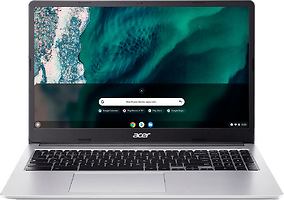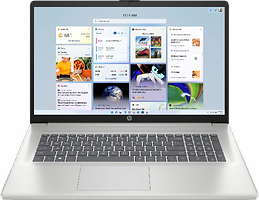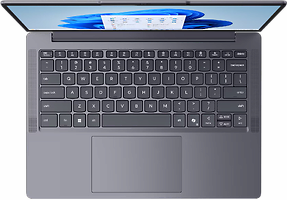Laptop Buyer’s Guide - How to Find the Perfect Laptop
 © Unsplash
© Unsplash- The Most Important Questions
- Laptop Categories
- When Size is Decisive
- Shopping a Laptop for Specific Features
- Hardware Guide: CPU, GPU, RAM, SSD and Co.
- Display Technologies: Full HD up to 4K & TN, IPS, OLED from 60 to 240 Hz
- Connections & Features: USB-C, HDMI, Wi-Fi and Thunderbolt 4
The Most Important Questions
A laptop contains everything: Screen, processor, keyboard, mouse, power supply. The whole thing is mobile, fits in a rucksack or leaves plenty of space on the desk. There are many good reasons to opt for a laptop instead of a stationary desktop PC.
But not all laptops are the same; there are specially customised devices for different requirements. In our buying guide, we present different types of notebooks and explain what you need to look out for in terms of price, size and use cases as well as processor, graphics, display, memory and connections. We provide a price range for different categories, features and requirements as a guide.
Laptop Categories
Let's just start with the most common notebook categories, at best you can sort yourself roughly and narrow down the selection for your purchase:
Price: Laptops for less than £500
Here you will find laptops with a minimum configuration in terms of performance, battery and display or older models on sale. This price range includes many sizes, the devices are usually kept simple, plainly processed and don't cost the earth. Sufficient for texts and videos.
Laptops under £500
Price: Laptops below £1.000
In this price range, you get devices for versatile use: Internet, video streaming, office, social media, editing holiday photos. They are also variable in size: from 12 to 17 inches, everything is included. Some of the laptops here also have luxury features such as metal housings, backlit keyboards or basic gaming power.
Laptops under £1.000
Multimedia Laptops
For many, these laptops are already replacing a fully-fledged desktop PC and are priced between 700 and 1200 pounds. They are capable of photo and video editing, offer decent sound and last five or more hours away from the power socket. You can even fire up a game on their typically 15 to 17 inch displays.
Multimedia Laptops
Gaming Laptops
The bodybuilders among laptops: they start at £800 and can easily be priced in the mid four-digit range. Gaming laptops use powerful gaming and high-end processors and dedicated graphics chips from Nvidia or AMD. The cooling is correspondingly powerful, which usually fits into form factors of 15 inches and larger. The battery capacity of gaming devices rarely lasts for more than 2-3 hours and without a power outlet, performance usually drops drastically.
Gaming Laptops
Apple MacBooks
First-class hardware meets elegant design and a macOS operating system that simply runs smoothly. Apple has demonstrated how the perfect interplay between software and hardware can look with its own M processors. You can buy the small and light Apple MacBook Air from as little as £1,000. The MacBook Pro series offers more power in the 13, 14 or 16 inch sizes. With Apple's M chips, up to 8 TB SSD and 96 GB RAM, the MacBook Pro is one of the most powerful notebooks ever - and still only weighs 2 kilos.
Apple MacBooks
Ultrabooks
Small and sexy! These flat mobile PCs with 12, 13 or 14 inch displays are extremely portable, weigh barely more than a kilo and are still fast and powerful thanks to processors with eight or more cores and SSDs. The battery life of the Thin & Lights is also at least six hours and can be more than double that. Metal housing, touchscreens, backlit keyboards, Thunderbolt 4... A whole host of features make ultrabooks attractive work devices, but you also have to budget at least £800 for them.
Ultrabooks
2-in-1 Convertibles
Notebook and tablet in one - flexible, light, fast and convenient. With touchscreens, 360-degree hinges or completely detachable displays, convertibles are the most versatile mobile PCs. Entry-level prices start at 500 pounds, and 2-in-1s can cost more than 2,000 pounds depending on the features and performance.
2-in-1 Convertibles
Business Laptops
Companies often have special requirements when it comes to mobile work devices. Business laptops often come with Windows 11 Pro, are easier to manage remotely by an IT department, are more robust and enjoy longer support. When it comes to connectivity, reliability and compatibility are also more important than the sleekest and flattest possible casing. Well-known manufacturers such as Lenovo, HP and Acer offer a variety of devices for business purposes.
Business Laptops
Chromebooks
Almost everything here takes place in the Google cloud, or more precisely in the Chrome browser. You don't need to install anything extra for the web applications, no patches, no virus protection and only a small amount of storage space. But an internet connection is essential. E-mails, texts, spreadsheets, surfing, multimedia and social media also run smoothly on Chrome OS. As Chromebooks are usually very inexpensive and uncomplicated, they are favoured in the education sector.
Chromebooks
Workstations
Video rendering, 3D modelling, image processing - mobile workstations are primarily used for graphics-intensive applications. The purchase prices of the powerful 15- and 17-inch laptops start at over 1000 pounds, and it is usually the professional graphics cards from the Nvidia RTX A or AMD Radeon Pro series that are responsible for the high costs. Proprietary drivers, longer support, software certifications and more precise calculations are the advantages here.
Workstations
When Size is Decisive
However, you can also choose your new laptop according to a few key criteria. For example, we have divided the models into sizes in this buying guide:
Netbooks
Netbooks have actually been around for almost 10 years. The inexpensive mini devices with displays between 7 and 12 inches can handle emails, texts and surfing the internet. However, you only come across them occasionally because 13-inch displays now also fit into a handy format without much fuss.
13” Laptops
The majority of ultrabooks and thin & lights fall into this popular form factor. 13-inch laptops are rarely heavier than 1.3 kilos and are therefore extremely portable. Whether you're travelling to university or the office, it's best to keep the weight within limits for daily commuting. You don't necessarily have to compromise on performance or battery life either. Intel processors or AMD Ryzen also pack eight or more cores into such small laptops and with SSDs and eight to 32GB of RAM, you basically get a fully-fledged PC. In some cases, you can even find gaming laptops in this form factor.
13” Laptops
15” Laptops
Devices in this form factor are not quite as portable as 13-inch models, but they have a larger screen for multitasking, entertainment or gaming. In models with a 15.6-inch display diagonal, manufacturers can accommodate better cooling systems and therefore also more graphics power. This format covers a wide range. The cheapest laptops can also be found in this category.
15” Laptops
17” Laptops
17-inch devices are quite large for a laptop and are therefore considered a desktop replacement system. The weight is between 2.5 and 5 kilograms and all applications are covered, from office (from 300 pounds) to multimedia (from 550 pounds) to gaming.
17” Laptops
Shopping a Laptop for Specific Features
Are you looking for very specific features? Touchscreen laptops, models without an operating system or with Windows 11? We have also grouped the devices into categories for this purpose.
Touchscreen Laptops
Laptops with touchscreen are really fun. There is a before and an after, you have to try it out and get used to it - after that you usually don't want to go back. Netbooks with touchscreens are available for less than 200 pounds, while larger touchscreen devices with 256 GB SSD, full HD resolution and faster Intel Core processors are also available from 500 pounds.
Laptops with SSD
No longer without it! An SSD is the be-all and end-all when it comes to how fast a laptop feels. Boot times, programme launches, copying processes - at least the important things like the operating system and frequently used programmes should be stored on the fast flash memory. Traditional hard disc drives (HDDs) have been superseded for so long that SSDs are now also available at a reasonable price.
Laptops with Windows 11
Microsoft Windows is the most widely used operating system. Alternatives are MacOS or Linux. Of course, there are also laptop models completely without an operating system.
Laptops without an Operating System
Quite a few of the cheapest laptops come without an operating system and are therefore so inexpensive. This is usually labelled ‘oOS’ or ‘FreeDos’. If you have perhaps already bought Windows, you can install it there. Or you can buy Windows 11 with an OEM key for 10 to 15 pounds on eBay and the like. These activation keys come from volume licences or have been detached from PCs. The purchase is legal, but it can happen that the keys have already been used and are unusable.
Hardware Guide: CPU, GPU, RAM, SSD and Co.
Let's take another quick look at the innards of a laptop. These are basically all the components that are also installed in a PC. At this point, we will also introduce display technologies, i.e. what 4K, IPS or OLED is all about, and then we will list the most common connections on a laptop.
Processor or CPU (Central Processing Unit)
The CPU is the brain on the motherboard, so to speak, where all the other organs are brought together. It comes from either Intel or AMD and is divided into several classes in terms of performance and power consumption.
CPUs with a consumption of less than 10 watts are usually found in very thin, sometimes passively cooled (without a fan) devices. Even with 15 to 28 watts (Apple MacBook Pro), they are still referred to as energy-saving processors. They can have as many as ten cores or more and are used in ultrabooks or other thin and light devices, but are also suitable for multimedia.
The most powerful processors in laptops consume around 55 watts, have up to 24 cores and are only just behind their desktop alternatives. As gaming and high-end processors, they are usually found in multimedia or gaming laptops with a screen diagonal of 15.6 inches or more.
Graphics Card or GPU
Almost all laptop processors have an integrated graphics card (iGPU). The component responsible for the graphics output to the display is located directly on the chip. These integrated graphics units are called Intel UHD, Intel HD, Intel Iris Xe, Intel Arc, Intel Graphics; AMD Radeon or AMD Vega in the case of an AMD CPU. They can handle office tasks, multimedia, as well as light gaming and editing.
For 4K video editing, 3D rendering or gaming, there are also additional, so-called ‘dedicated’ graphics cards from Nvidia and AMD. GPUs with the same name are also somewhat slower in laptops than their desktop counterparts and are also somewhat more expensive.
Memory or RAM
‘Random access memory’ is a cache in which programmes can temporarily store data for quick retrieval. Whether operating system, multimedia, gaming or browsing - all applications use the main memory. If this becomes too small, queues have to be processed.
With four or eight GB of RAM, several windows of a Chrome browser with a corresponding number of tabs can lead to full utilisation. However, with eight GB, it is generally assumed that the RAM is sufficient for all common applications. With 16 GB or more, however, you are definitely on the safe side. Content creators who work with the Adobe Suite (After Effects, Photoshop, Premiere) can also fill up 32 GB.
SSD and HDD
In addition to RAM as fast intermediate storage, there is also mass storage in the laptop on which data is permanently stored. Until a few years ago, this was done exclusively magnetically on fast-rotating discs in the hard drives. Then SSDs with memory cells appeared and became increasingly affordable. They are many times faster and, for many users, the component that contributes most to the perceived speed of a laptop.
Laptops with 128 GB SSD memory as a system drive can quickly become cramped, so it's better to go for 256 GB or more. Even if more SSD capacity is sometimes associated with hefty surcharges for some models, you save a lot of time and nerves because you don't have to constantly clear the drive. Operating systems grow over time due to updates, so you should not choose the smallest SSDs even if you want to save data. Fast flash memory can be easily retrofitted in many older laptops.
Display Technologies: Full HD up to 4K & TN, IPS, OLED from 60 to 240 Hz:
Another important factor in the laptop is the screen. There is really only one thing to consider when it comes to resolution: From Full HD, which means 1,920 x 1,080 pixels, everything is sharp enough. 4K displays are even sharper at 3,840 x 2,160 pixels, but this only comes into play with 15.6- or 17.3-inch displays. A higher resolution has a significant impact on battery life.
However, there are several special cases for other properties such as brightness, viewing angle stability, colour space coverage and speed. From a brightness of 300 nit (or candela), the displays are suitable for outdoor use. With a matt coating, this is even better than with a glossy surface such as touchscreens, for example. The same applies here: reduced brightness means longer battery life.
In inexpensive laptop models under 500 pounds, TN panels are usually used; this screen technology is less colour-fast and viewing angle stable than IPS. The latter are therefore recommended for office and multimedia. As TN displays are faster and require less response time to change their pixels, they are often used in gaming laptops. A smoother display is an advantage for gamers.
This brings us directly to the next important feature: the refresh rate. Normally, the typical 60 Hz is perfectly adequate. Here, too, it is gamers who are catered for by more far-reaching technologies. The ‘refresh rate’ of the displays, i.e. the cycle in which the image is refreshed, increases to 144 or even 240 Hz in some gaming devices. In new laptops with integrated AI, there are now also screens with dynamic refresh rates that can be adjusted depending on the application and thus help to save energy.
Last but not least, OLED displays are a completely new trend. As the pixels themselves light up, they do not require a backlight and are unbeatable in terms of black level, contrast and colour space coverage. Such panels are great for image or video editing, but also for multimedia enjoyment - although they do come at a considerable extra cost.
Connections & Features: USB-C, HDMI, Wi-Fi and Thunderbolt 4
USB is still the most important interface, most commonly in its new form USB-C and in its old version USB-A. You need USB-A for USB sticks, mice, many hard drives, cameras and phones. However, there are now also many peripheral devices that can be connected to a USB-C port.
Laptops that do without this port are often accompanied by an adapter hub that turns one USB-C port into all the others. USB-C also accommodates displays, as long as they are at least USB 3.1 Gen 2 with DisplayPort. USB-C delivers the greatest bandwidth via Thunderbolt 4 and it is not uncommon for a laptop to be charged via USB-C. In combination with a powerful power bank, this enables extremely long usage times when travelling.
Another important connection is HDMI. In full size, it enables the image to be output to televisions, projectors or monitors. This is particularly practical when travelling.
And last but not least, the network: while many laptops do without the wired ‘Ethernet’ connection, pretty much all of them come with a WiFi module. It doesn't have to be the latest WiFi 7, WiFi-ac is perfectly adequate.





